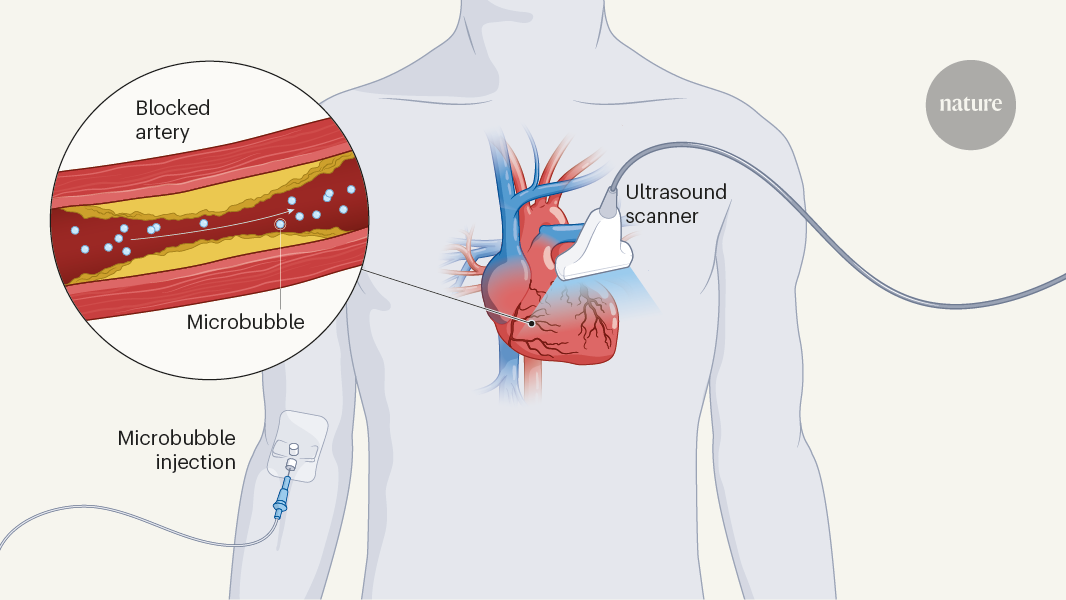Microbubble Ultrasound: A Promising Technique for Early Detection and Monitoring of Heart Disease
Core Concepts
Microbubble-enhanced ultrasound imaging can provide real-time, quantitative assessment of coronary artery narrowing and myocardial perfusion, enabling earlier detection and better monitoring of heart disease.
Abstract
The article discusses the potential of a novel microbubble-enhanced ultrasound imaging technique to address the limitations of current tools for detecting and monitoring heart disease.
Key highlights:
- Coronary artery disease is a major cause of mortality in the US, with someone experiencing a coronary event every 34 seconds and a related death every 83 seconds.
- Existing tools for detecting narrowing of the coronary arteries often fail to identify the problem early enough for effective pharmacological intervention.
- Similarly, after a coronary event, it is challenging to accurately assess the extent of damage to the heart muscle and predict future outcomes.
- The new microbubble ultrasound approach reported in Nature Biomedical Engineering can provide real-time, quantitative mapping of blood flow in the heart, enabling earlier detection of coronary artery narrowing and better monitoring of myocardial perfusion after an event.
- This technique can be deployed in emergency departments, potentially improving diagnosis and treatment of cardiovascular disease.
Customize Summary
Rewrite with AI
Generate Citations
Translate Source
To Another Language
Generate MindMap
from source content
Visit Source
www.nature.com
Microbubble ultrasound maps hidden signs of heart disease
Stats
Every 34 seconds, someone in the US has a coronary event.
Every 83 seconds, a coronary event results in death.
Quotes
"If people survive a coronary event, this deficiency also makes it challenging to work out the severity of the injury and the potential future outcomes, which could be determined by mapping blood flowing through the part of the heart muscle that remains viable."
Key Insights Distilled From
by Elisa E. Kon... at www.nature.com 05-06-2024
https://www.nature.com/articles/d41586-024-01194-2
Deeper Inquiries
How can this microbubble ultrasound technology be further improved and optimized for widespread clinical adoption?
To enhance the clinical adoption of microbubble ultrasound technology, several improvements can be implemented. Firstly, increasing the portability and ease of use of the machinery can make it more accessible in emergency departments and other healthcare settings. This could involve developing smaller, more user-friendly devices that can be easily maneuvered. Additionally, refining the real-time, quantitative capabilities of the technology to provide more accurate and detailed information about blood flow in the heart muscle can improve its diagnostic value. Collaborating with healthcare professionals to integrate this technology seamlessly into existing workflows and protocols can also facilitate its widespread adoption.
What are the potential limitations or drawbacks of this approach compared to other emerging cardiovascular imaging techniques?
While microbubble ultrasound technology offers significant advantages, it also has some limitations compared to other emerging cardiovascular imaging techniques. One drawback is the dependency on the skill of the operator to obtain high-quality images and interpret the results accurately. This can lead to variability in outcomes and may require specialized training for healthcare professionals. Additionally, the resolution of ultrasound images may not be as high as that of other imaging modalities such as MRI or CT scans, limiting the level of detail that can be captured. Furthermore, the cost of implementing and maintaining ultrasound equipment may be a barrier to widespread adoption in resource-limited settings.
How might this technology enable new insights into the underlying mechanisms and progression of coronary artery disease?
Microbubble ultrasound technology has the potential to provide valuable insights into the underlying mechanisms and progression of coronary artery disease. By mapping blood flow through the heart muscle in real-time and quantitatively assessing the severity of arterial narrowing, this technology can help clinicians understand the hemodynamic changes associated with the disease. This information can aid in early detection, risk stratification, and treatment planning for patients with coronary artery disease. Furthermore, by enabling visualization of the microvasculature and perfusion patterns within the heart muscle, microbubble ultrasound can offer insights into the regional effects of arterial blockages and the potential for collateral circulation to compensate for compromised blood flow. These insights can inform personalized treatment strategies and improve patient outcomes.
0
